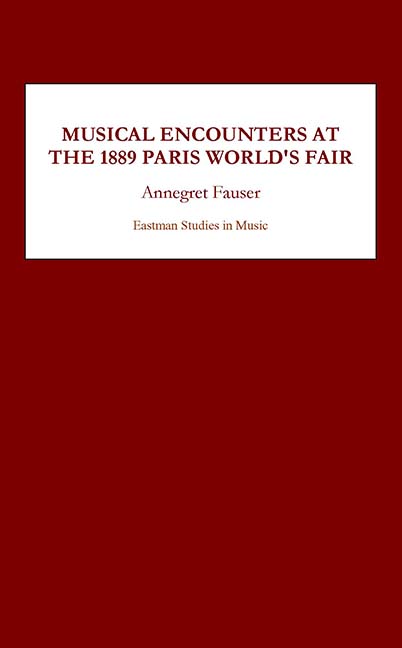Book contents
- Frontmatter
- Dedication
- Contents
- List of Figures
- List of Tables
- List of Music Examples
- Acknowledgments
- List of Abbreviations
- Introduction: The Soundscape of the 1889 Exposition Universelle
- 1 Exhibiting Music at the Exposition Universelle
- 2 Opera, Ballet, and the Politics of French Identity
- 3 The Republic’s Muse: Augusta Holmès’s Ode triomphale
- 4 French Encounters with the Far East
- 5 Belly Dancers, Gypsies, and French Peasants
- 6 The Marvels of Technology
- Appendix 1 Programs of Concerts at the Exposition Universelle
- Appendix 2 Performances at the Opéra and the Opéra-Comique during the Exposition Universelle
- Dramatis Personae
- Bibliography
- Index
- Eastman Studies in Music
- Musical Encounters at the 1889 Paris World’s Fair
4 - French Encounters with the Far East
Published online by Cambridge University Press: 26 May 2022
- Frontmatter
- Dedication
- Contents
- List of Figures
- List of Tables
- List of Music Examples
- Acknowledgments
- List of Abbreviations
- Introduction: The Soundscape of the 1889 Exposition Universelle
- 1 Exhibiting Music at the Exposition Universelle
- 2 Opera, Ballet, and the Politics of French Identity
- 3 The Republic’s Muse: Augusta Holmès’s Ode triomphale
- 4 French Encounters with the Far East
- 5 Belly Dancers, Gypsies, and French Peasants
- 6 The Marvels of Technology
- Appendix 1 Programs of Concerts at the Exposition Universelle
- Appendix 2 Performances at the Opéra and the Opéra-Comique during the Exposition Universelle
- Dramatis Personae
- Bibliography
- Index
- Eastman Studies in Music
- Musical Encounters at the 1889 Paris World’s Fair
Summary
Although the various concerts, opera performances, and centennial festivities of and around the 1889 Exposition Universelle contributed to the unparalleled presence of music at a World's Fair, it was the music of cultures perceived as “Other”—whether European folk music or more exotic species from the Near and Far East—that most excited visitors and commentators alike. Romanians, Hungarians, Arabs, and Gypsies enriched the sonic landscape of the many restaurants and cafés scattered along the Champ de Mars, while sounds never heard before by (most) European ears, such as those of the Javanese gamelan and the Vietnamese Theater, brought new thrills to the listening experience of the Exposition by providing a new soundtrack for the by now all-too-familiar exoticisms of prints, novels, theater, and popular entertainment. These sounds, in particular those that pervaded the colonial exhibition of the Esplanade des Invalides, generated sonic encounters of the “Other” that redrew the boundaries of musical experience both of musicians like Claude Debussy and of the wider Exposition audience. Listeners whose musical experience of the East thus far was one created by the imaginary world of European exoticism now came face to face with “the real thing,” usually for the first time. The two sonic worlds proved irreconcilable. This gap between the imagined and the real became one of the main threads of the sonic perception and reception of non-Western music during the 1889 Exposition Universelle. The music of other cultures was often too unfamiliar to be enjoyed comfortably as mere sonic background to the sampling of local foods in cafés. Visitors also encountered the jarring reality of sounds that accompanied the spectacle of the exotic, and began listening actively to these “new” and exotic musics that had come from afar to the Exposition Universelle on the banks of the Seine. The reactions were not always positive.
Musical Exoticism and the Listening Imagination
It is difficult to gauge the listening imagination and sonic experience of European listeners in the late 1880s from the vantage point of the early twentieth-first century. But although we can neither recreate the sonic horizon of expectation for an imagined 1889 listener, nor listen ourselves to music with 1889 ears (an issue discussed further in chapter 6), we can nevertheless rely on circumstantial evidence that may allow us to evaluate to some degree these European encounters with the musical “Other.”
- Type
- Chapter
- Information
- Musical Encounters at the 1889 Paris World's Fair , pp. 139 - 215Publisher: Boydell & BrewerPrint publication year: 2005



